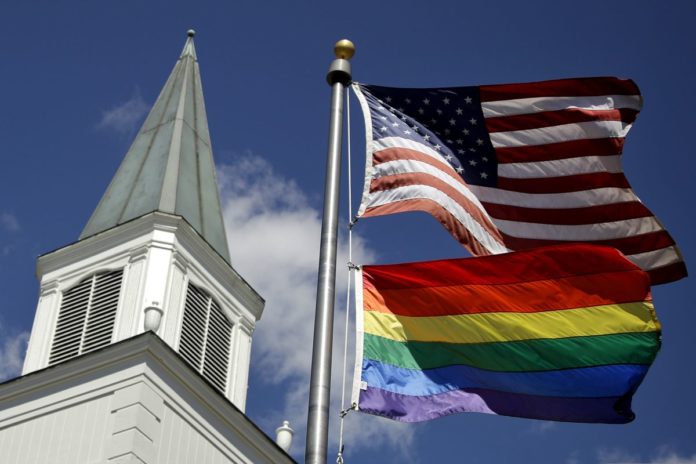
What if the defining gay rights demand of the past generation had not been equal marriage rights but an affirmative-action program for employment in areas – say, the federal government – where gay men and lesbians had suffered historic discrimination?
That’s a question I asked myself as I wondered about the remarkable turn the debate over same-sex marriage took over the past decade. As marriage equality rose to national attention in the mid-1990s, it was widely assumed that a subject with such deep religious and moral meaning would produce the type of long and grinding conflict that would occupy the country for generations. Indeed, for much of the 2000s, marriage was the most contentious domestic issue in the country. Yet by the next decade, it seemed to have disappeared as a subject for live political debate just as quickly as it had emerged. Even as conservatives fight for religious-liberty exemptions from the new norms around same-sex marriage, such as those the Supreme Court is considering in a challenge from a Catholic social-services agency that refuses to place foster children in gay families, they’ve effectively conceded defeat in the broader war over the law.
The earlier civil rights projects to which the quest for marriage equality was often compared – notably, for women’s suffrage and racial desegregation – not only took much longer to reach their goals but also appeared to leave a residue of unresolved conflict even after the constitutional issues were settled. While there are many useful points of analogy among these social movements, notably in terms of strategy and tactics, a big difference explains why this one played out so differently: Those in power did not have to give anything up to agree to the demand for marriage equality.
Imagine the defining civil rights struggles of American history not just as quests for equality and justice but as contests over scarce resources. Full property rights for women, which proceeded suffrage as the first major women’s rights campaign, compromised the wealth of husbands and fathers. Expanding the right to vote across gender and racial lines diluted the political power of White men. Increased rights and opportunities for immigrants have been seen as a threat to jobs for the native-born. Educational integration generated rivalry for space in neighborhood schools; nondiscrimination laws increased competition among renters and buyers in historically segregated communities. The Americans With Disabilities Act forced building owners to budget for retrofitting their properties.
Early on, it seemed like the marriage equality fight would proceed the same way. Those defending the status quo initially thrashed about for ways to characterize the damage that a change in the law would supposedly have. In the spring of 1996, White House talking points on the topic – which President Bill Clinton personally approved – argued that the president “does not believe it is appropriate for scarce federal resources to be devoted to providing spousal benefits to partners in gay and lesbian relationships.” That fall, after its Supreme Court became the first on Earth to rule that the fundamental right to marriage might extend to same-sex couples, Hawaii was forced to justify their exclusion at trial. In pretrial statements, the state attorney general’s office auditioned a range of potential rationales: that Hawaii authorities had an interest in ensuring that the state’s legal relationships were recognized in other jurisdictions; that the state had an interest in furthering procreation within marriage; that heterosexual marriages were better for children; that the islands’ tourist economy could suffer if Hawaii became Lake Tahoe for gay and lesbian couples.
But none of these rationales managed to persuade judges – either in Hawaii or in subsequent successful challenges to marriage laws in Vermont, Massachusetts, Connecticut, California and Iowa. After the first federal trial in 2010, about the constitutionality of California’s Proposition 8, which banned same-sex marriage, U.S. District Judge Vaughn Walker delivered a withering assessment of “the minimal evidentiary presentation” that the law’s defenders had made in his San Francisco courtroom. “The trial evidence provides no basis for establishing that California has an interest in refusing to recognize marriage between two people because of their sex,” Walker wrote.
Judges also brushed aside the most significant menace that marriage opponents invoked: that clergy could be compelled to officiate nuptials against their beliefs. When the Church of Jesus Christ of Latter-day Saints attempted to formally intervene in the Hawaii trial, on the basis that its nonprofit status could be at stake if it refused to participate in same-sex marriages, the state Supreme Court dismissed the request, saying that the church had no “interest relating to the property or transaction” at stake. In a landmark 2003 decision ordering town clerks to let same-sex couples marry, Massachusetts’s top court explained that its opinion “in no way limits the rights of individuals to refuse to marry persons of the same sex for religious or any other reasons.” States that passed legislation on the question, like New York, included explicit religious exemptions.
When Massachusetts began permitting the first legal American same-sex marriages, in 2004, opponents lost their most powerful political rhetoric. Beforehand, they brandished apocalyptic visions of what would follow. Sen. Rick Santorum (R-Pa.), who had likened the 2003 Massachusetts ruling to the 9/11 attacks, observed that “the family is the bedrock of our society. Unless we protect it with the institution of marriage, our country will fall.” But afterward, even the most cynical observers of events in Massachusetts and the states that followed its lead could not point to any societal decay that gay marriage brought.
In both the legal and political spheres, opponents were forced to shrink the circle of those expected to feel direct harm from letting gay men and lesbians marry. By the start of the 2010s, same-sex marriage opponents were basically reduced to arguing that the status quo protected children, both those who would be raised (under supposedly disadvantaged conditions) in same-sex households and those who weren’t but were being taught in school to accept them. When asked to identify who actually had been hurt, opponents would point to the same handful of high-profile examples: the Massachusetts man arrested for trespassing when he challenged school officials over the materials in his son’s “diversity book bag” depicting a lesbian couple with children, or the San Francisco elementary-schoolers taken on a class trip to watch their lesbian teacher wed at City Hall. Even if simple exposure to gay families caused harm to children (and gay-marriage opponents could never muster anything beyond conjecture to support that claim), they did not bring much to the fight against same-sex marriage as voters, donors or activists.
At the same time, the coalition of those invested in legalizing same-sex marriage not only broadened, but their investment in the outcome deepened. This included not just gay couples who wanted to marry – drawn to the unique material benefits and symbolic power the institution offered – but their families and communities who saw marriage as a source of stability, and even employers who wanted to synchronize their benefits with the law and standardize them across state lines. Even those who had won the right to wed where they lived had a material interest in continuing to agitate for a change in the law, since the Defense of Marriage Act denied them any of the federal benefits available to married couples, and the recognition of their relationship was at risk whenever they crossed state lines.
This all generated a very different dynamic than other social movements, which include a contest not only over public values – equality, liberty, justice – but also for scarce resources. During the civil rights movement, Black activists determined that the strongest White resistance would come in areas where those public values were at stake. Research published by the sociologist Gunnar Myrdalin 1944 showed that White Americans overwhelmingly prioritized keeping “the bar against intermarriage” rather than restrictions on voting rights, schooling or public accommodations. Civil rights organizations waited until they had knocked down Jim Crow laws in those areas before challenging race-based marriage classifications. Even then, it was the American Civil Liberties Union, not the NAACP, that filed the Loving v. Virginia lawsuit, which led the Supreme Court to strike down intermarriage bans in 1967.
But ultimately the Loving decision did not provoke much of a direct political reaction, in part because no one who saw themselves on the losing side had to give anything up. Despite its momentousness, it now looks like a blip between the far more contentious responses to 1954′s Brown v. Board of Education, which desegregated public schools, and 1978′s Regents of the University of California v. Bakke,which upheld affirmative-action programs.
It was an accident of history, catalyzed by local events in Hawaii, that marriage equality rose to the top of the gay rights agenda at the start of this century. That’s what had me wondering about counterfactuals: How would the politics have been different if otherwise liberal-minded parents worried that their children would miss out on employment opportunities for which queer candidates were given preferential treatment? Or what if each state had only a set number of marriage licenses to give out each year, and each time one went to a gay couple, a straight couple had to wait?
As a matter of implementation, changing marriage laws is easy: It typically requires local clerks and state officials to alter a few words on a form. Ultimately, it doesn’t create any losers, which may be one reason those who lost the battle over marriage rights have flocked to religious-liberty cases championing people who claim that being forced to acknowledge the change in law violates their beliefs. In cake bakers and foster-care agencies, gay-marriage opponents finally found people who felt they had something to lose.








